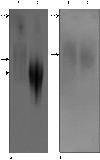The role of crude saliva and purified salivary mucins in the inhibition of the Human Immunodeficiency Virus type 1
- PMID: 22929306
- PMCID: PMC3441277
- DOI: 10.1186/1743-422X-9-177
The role of crude saliva and purified salivary mucins in the inhibition of the Human Immunodeficiency Virus type 1
Abstract
Background: Sub-Saharan Africa is the world's worst HIV-AIDS affected region. More interventions to manage this pandemic are urgently required. Transmission of the virus through an exchange of saliva is rarely known to occur. This project sought to verify statistically previous findings in our laboratory, that crude saliva from uninfected individuals together with its purified mucin components inhibited HIV-1, whilst mucins from infected saliva did not show this inhibition, in an in vitro assay.
Methods: Saliva was extracted in 4 M guanidinium hydrochloride and proteolytic inhibitors at pH 6.5, followed by the isolation of MUC5B and MUC7 by Sepharose 4B gel filtration and further purification of these mucins by density-gradient ultra-centrifugation in caesium chloride. Agarose gel electrophoresis, Western blotting and amino acid compositional analysis determined the size, purity and identity of the mucins. The inhibitory activity of crude saliva and purified MUC5B and MUC7, from HIV negative (n=20) and HIV positive (n=20) donors, was tested by their incubation with subtype C HIV-1 and subsequent infection of peripheral blood mononuclear cells (PBMCs). PCR was done on tandem repeat regions of MUC5B and MUC7 DNA to investigate whether any association existed between gene polymorphism and susceptibility to infection.
Results: There was an inter-individual variation in the amounts of MUC5B and MUC7 in saliva. In contrast to previous studies, crude saliva and purified mucins from both HIV negative and HIV positive individuals inhibited the infection of HIV-1 in an in vitro assay. DNA analysis of the tandem repeat regions of MUC5B and MUC7 revealed no difference between groups.
Conclusions: Crude saliva and its mucins, MUC5B and MUC7, from both uninfected controls and HIV positive individuals inhibited HIV-1 in an in vitro assay.
Figures





Similar articles
-
Mucus and Mucins: do they have a role in the inhibition of the human immunodeficiency virus?Virol J. 2017 Oct 6;14(1):192. doi: 10.1186/s12985-017-0855-9. Virol J. 2017. PMID: 28985745 Free PMC article. Review.
-
The role of crude human saliva and purified salivary MUC5B and MUC7 mucins in the inhibition of Human Immunodeficiency Virus type 1 in an inhibition assay.Virol J. 2006 Nov 24;3:99. doi: 10.1186/1743-422X-3-99. Virol J. 2006. PMID: 17125499 Free PMC article.
-
Anti-HIV-1 activity of salivary MUC5B and MUC7 mucins from HIV patients with different CD4 counts.Virol J. 2010 Oct 14;7:269. doi: 10.1186/1743-422X-7-269. Virol J. 2010. PMID: 20946627 Free PMC article.
-
The comparative inhibitory potency of salivary mucins against human immunodeficiency virus type 1.Virology. 2021 Jan 15;553:1-8. doi: 10.1016/j.virol.2020.10.004. Epub 2020 Oct 26. Virology. 2021. PMID: 33190061
-
The anti-HIV-1 activity associated with saliva.J Dent Res. 1997 Feb;76(2):634-40. doi: 10.1177/00220345970760020301. J Dent Res. 1997. PMID: 9062556 Review.
Cited by
-
Antimicrobial peptides: Defending the mucosal epithelial barrier.Front Oral Health. 2022 Aug 1;3:958480. doi: 10.3389/froh.2022.958480. eCollection 2022. Front Oral Health. 2022. PMID: 35979535 Free PMC article. Review.
-
Characterization of Oral Immunity in Cases and Close Household Contacts Exposed to Andes Orthohantavirus (ANDV).Front Cell Infect Microbiol. 2020 Nov 3;10:557273. doi: 10.3389/fcimb.2020.557273. eCollection 2020. Front Cell Infect Microbiol. 2020. PMID: 33224896 Free PMC article.
-
Airway Surface Liquid Has Innate Antiviral Activity That Is Reduced in Cystic Fibrosis.Am J Respir Cell Mol Biol. 2020 Jan;62(1):104-111. doi: 10.1165/rcmb.2018-0304OC. Am J Respir Cell Mol Biol. 2020. PMID: 31242392 Free PMC article.
-
Mucus and Mucins: do they have a role in the inhibition of the human immunodeficiency virus?Virol J. 2017 Oct 6;14(1):192. doi: 10.1186/s12985-017-0855-9. Virol J. 2017. PMID: 28985745 Free PMC article. Review.
-
Salivary mucins in host defense and disease prevention.J Oral Microbiol. 2015 Dec 22;7:29759. doi: 10.3402/jom.v7.29759. eCollection 2015. J Oral Microbiol. 2015. PMID: 26701274 Free PMC article.
References
-
- UNAIDS Epidemic Update 2010 GLOBAL REPORT. http://www.unaids.org/globalreport/documents/20101123_GlobalReport_full_....
-
- Bergey EJ, Cho MI, Blumberg BM, Hammarskjold ML, Rekosh D, Epstein LG, Levine MJ. Interaction of HIV-1 and human salivary mucins. J Acquir Immune Defic Syndr. 1994;7(10):995–1002. - PubMed
MeSH terms
Substances
LinkOut - more resources
Full Text Sources
Medical

